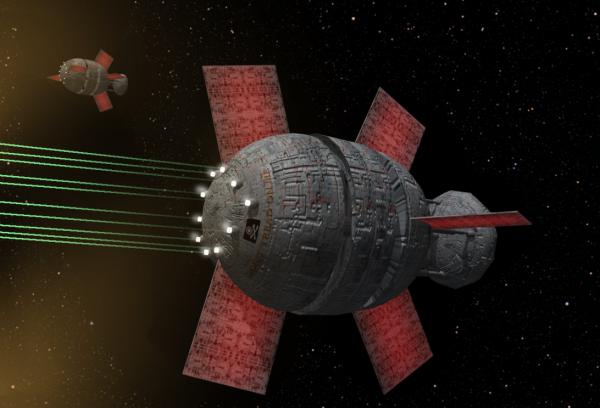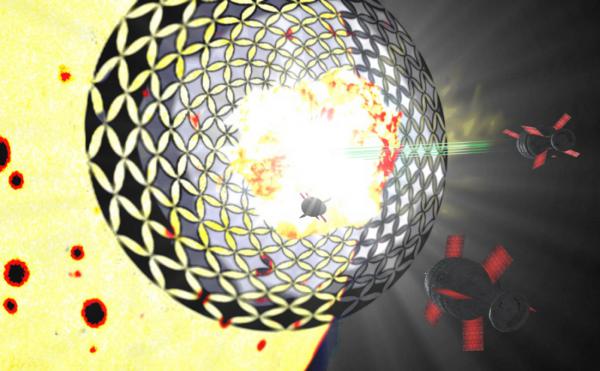BY LETTER
Cowboys and Gung Hos
Backyarder factions from the Interplanetary Age | |
 Image from Steve Bowers | |
| The Gung-Ho ships Don't Tread on Me and Battleborn attack Amat Station B4 (just before it exploded) | |
By the early Golden Age there were many who felt that history had well and truly passed the old nation state of America by. It was still prosperous and influential, and a significant cultural force, but by that time a very large number of other nation-states had similar status with the general rise in wealth that had swept across the planet. Further, it had been diminished along its prosperous west coast by the independence of California and then Cascadia. Like all other nation-states it was far less powerful and influential within its own borders, due to the influence of large corporations, ecoregion management zones, and other transnational organizations and arrangements. Finally, like all of Old Earth's powers, it was overshadowed by the rising cultural, political and economic might of Solsys' newer powers. That some of these new powers were descended in whole or in part from American colonies only added to the sense of loss that some Americans felt. This was hardly unique on Old Earth; all over the planet, especially in the territories of former major powers, reactionary or extreme conservative groups hearkened back to a lost 'golden age' and dreamed of a future somewhere out 'among the stars' in which it might be restored. The nanotech revolution and the Backyarder phenomenon provided fuel for such dreams, an extreme form of Americanism. This manifested differently in different regions, but in the old heartland of the U.S.A. it took form of the "Cowboys", and in their most famously extreme faction-group the "Gung Hos".
The "Cowboys", were named in reference both to the "Wild West" interactives that had seen a resurgence at the time the movement began and to the equally popular "Cyberpunk" mythos that had become well established in earlier generations. Unlike their pre-Cyberian "Cyberpunk" contemporaries (some of whom, confusingly, to later historians, also called themselves "Cowboys"), many of the American Cowboys were extreme conservatives, with racist beliefs attached to the superiority of what they proudly referred to as "America's WASP heritage". They dreamed of a new frontier and a "manifest destiny" for a "true America" somewhere beyond the bounds and restrictions of their home polity, which they regarded as a corrupt and decayed shell of the original. They were encouraged by the endless controversy in the federal and state governments, and felt that since these were having so much difficulty adapting, that this was an opportunity to strike out on their own. This matched some aspects of Cowboy minarchist ideology very well. They began networking, sharing knowledge, and pooling resources just as other Backyarder societies were doing. Though much of the subsequent course of their development was never properly recorded due to their extreme concerns around data privacy, and much of what was recorded was lost in the data-wars of the Technocalypse and the years leading up to it, it is still possible to reconstruct an outline of their subsequent development.
Initially Cowboy groups were content to attempt to influence state politics, or to carve out so-called free-zones within their home states, and had some considerable early success in negotiating such spaces. The American government of the day was wary of a revival of secessionist ideas as past centuries had, and took into account the degree of popular sympathy for the Cowboy movement, and so it was content to leave these matters up to the states. Corporations and ecoregion managers likewise made their peace with the Cowboys in pursuit of their own goals. Though some of the most moderate Cowboy groups were content with this, others used their resources to go further afield. They were part of the general Backyarder movement towards seasteads, Antarctic colonies, and other entities not attached to any traditional Old Earth power. This too proved unsatisfactory in the long run, though. Prosperous though they proved to be, many of the earthbound Cowboy communities found the planet itself too crowded and the web of commerce and regulation too restrictive. They set their sights on interplanetary space. Thus over subsequent decades, funded by the ongoing success of their operations and by contributions from sympathetic groups, they established a number of colonies, some of them in near-earth orbit, others on Luna, and others still in the Belt. The majority of Cowboys were content with this, and many Cowboy communities went on to take part in the later Bubblehab movement. However some, the most ideologically driven, foresaw a time when Solsys itself would not be big enough, a time when a web of agreements, trade, regulation, and cultural exchanges would reduce their freedoms and erode their beliefs. Further, some were uncomfortable not only with the prominence of rival human groups but with the new societies that consisted of or incorporated posthuman or ai entities. The only solution, they decided, was to shoot for the stars.
 Image from Steve Bowers | |
| Gung Ho battle emblem | |
Historians have pointed out that the Gung Hos actually were doomed from the start. In order for humans to seriously colonise a planet in another solar system with the technology of the day a very large colony ship would have been required. It would have needed to house many thousands in cryonic suspension, enough material to be self-sustaining and able to recreate a technological infrastructure, many smaller exploration and landing craft, a minimal closed ecosystem with the tools to expand it upon arrival and of course an interstellar drive with extraordinary quantities of amat; quite probably much more than could be acquired in a single raid on even the largest stockpiles of the day. The Gung Ho leaders were undeterred by these facts, having come to believe that the megacorps were concealing the true extent of their inventories and that innate Gung Ho superiority and that their pluck and inventiveness would overcome technical difficulties on the way to interplanetary space. They were also confident that with various social and political controversies going on their preparations would go unnoticed and their theft unpunished for long enough for them to be able to use the stolen antimatter to escape Solsys. A number of raids on the big amat farms were tried, most without much success. The most infamous of these, however, was the B4 disaster of 524 AT.
Over the years the Gung Hos had become increasingly militant and well-organised; by various means they acquired technology and infrastructure in space, mostly in or around Near-Earth Asteroids and various bodies in the Belt; disguising their activity as harmless trading, they collected fissionable material and built a number of explosive-pulse warships armed with powerful railguns and lasers.
In 524 a fleet of two dozen heavily armed gunships were launched towards selected amat production and storage facilities in Solar orbit. They were protected by broadcasting official IFF codes acquired from a previous a software attack on amat corp systems. The attack also inserted a false schedule for a courier service, as far as any security forces were concerned the Gung Hos appeared as a scheduled third-party pick up. Upon arrival The Gung Hos' attempts to hack into the station's systems and shut down the security defense network appeared to succeed, but by then word of the assault had leaked out and it was actually a trap. As soon as they boarded the station they were met by a security force, who disabled the Gung Hos with simple knockout gas, tanglefoam, and shockerstunners. The attackers who had remained on the ships could not do anything, as a further attack on the station would risk the lives of their compatriots.
 Image from Steve Bowers | |
| The containment on the antimatter store at Amat Station B4 explodes, destroying five Gung Ho ships (and the station itself) | |
Desperate, the Gung Hos departed and set course for another amat station, the Jerusalem Macrotech station B4. B4 was close enough for the Gung Hos to reach before security ships could intercept them and they reasoned that the station wouldn't have the prepared defences of their first target. However without the element of surprise and with the IFF codes now invalid B4 station was able to fire upon the Gung Ho ships at long range. In the ensuring battle the amat depot, the station facilities and five armed colony ships were destroyed when the containment for the amat failed and the whole thing detonated.
Following the B4 disaster amat corps beefed up their security, drastically cutting outsourced courier contracts (in the short term this decreased the availability of amat causing financial difficulties for reliant industries) and tended to shoot first and ask questions later. Any unauthorised vessel was met by a withering hail of fire. Elsewhere in the Solar System and on Earth it was the same. The amat megacorps, with the collusion of local police and security forces, used inhouse and mercenary assassins to attack the Gung Hos (and anyone else unfortunate enough to be nearby) wherever they could find them. This was an element in the total breakdown of society that was soon to follow, and ultimately the conflicts between the Gung Hos and the amat corporations were swallowed up in the general chaos, just one more wave on a tempestuous ocean.
In the end the Gung Hos did manage to obtain a quantity of amat from various sources, some legitimate, others less so; but only two of their ships ever made it out of the Sol System: the Old Glory and the John Wayne, both hastily launched before the full Technocalypse descended. Neither was ever seen again. Other Gung Hos — quite a large number in fact — did make it to the Kuiper belt where they set up a number of colonies and were eventually assimilated into mainstream Haloist and Semperist culture. Others managed to establish bubblehabs, particularly on Saturn, but initial colony failures, warfare, interaction with the roil of other bubblehab cities, and cultural evolution of the few surviving isolationist communities meant that by the end of the course of the Solsys dark ages no recognizable trace of the Gung Hos remained.
References
Asmar Waage, Isabella Bukari, Tongxin Walia, Cossacks, Cowboys and Samurai: Archetypes and Echoes in the Interplanetary Age, Federation Institute for Disaster Studies, Roddenberry Habitat, 1237 AT
Related Articles
Appears in Topics
Development Notes
Text by M. Alan Kazlev
revised by Stephen Inniss and Ryan B
Initially published on 10 December 2002.
revised by Stephen Inniss and Ryan B
Initially published on 10 December 2002.






